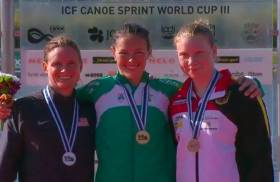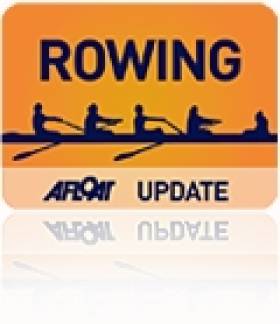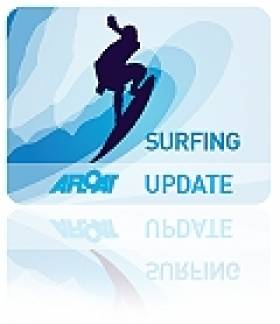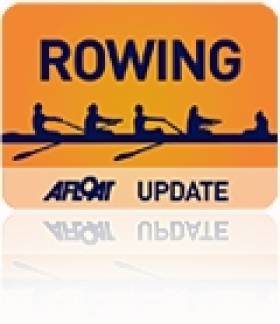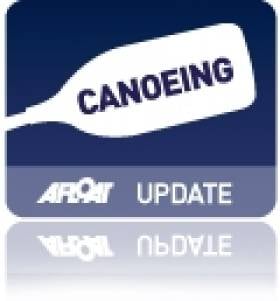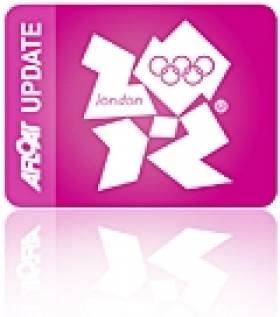Displaying items by tag: Gold
Dukarska is World Coastal Rowing Champion
#Rowing: Monika Dukarska took her second World title today. The Killorglin oarswoman won the women’s solo final at the World Coastal Rowing Championships in Monaco. She had over 26 seconds to spare over Greek international Alexandra Tsiavou (31) who finished second. Tsiavou took bronze in the lightweight double sculls at the Olympic Games in 2012.
Dukarska won this title for the first time in 2009 when the Championships were held in Britain. Earlier this year she took bronze at the World University Championships in the women's single sculls.
World Coastal Rowing Championships, Monaco, Day Two
(Irish interest; selected results)
Men
Quadruple – B Final: 10 Galley Flash 18:09.04. Solo – B Final: 7 B Hooper 20:32.86; 18 D Hussey 23:11.12.
Women
Solo – A Final: 1 M Dukarska 30:57.06, 2 A Tsiavou 31:23.35, 3 O Alfred 31:29.00. B Final: 3 J Lee 22:52.54, 4 S Healy 22:53.30.
Gold for Jenny Egan at World Cup
#Canoeing: Jenny Egan won a gold medal at the canoe sprint World Cup in Montemor-o-Velho in Portugal today. In a sprint to the line in strong winds Egan had .99 of a second to spare over Margaret Hogan of the United States. Melanie Gebhardt of Germany took the bronze. Egan also reached the A Final of the K1 500 metres.
The Salmon Leap paddler took silver in the last World Cup in Racice in the Czech Republic.
Ireland Strike Gold at Coupe de la Jeunesse Rowing
#ROWING: Ireland crews had another very good day at the Coupe de la Jeunesse junior rowing tournament in Bordeaux in France today. The highlight was a gold medal for the Ireland quadruple of Colm Hennessy, Eoghan Whittle, Patrick Munnelly and Andrew Goff. The men’s double of Conor Carmody and David O’Malley and the women’s pair of Oisin and Dervla Forde both took silver, as they had on Saturday.
Coupe de la Jeunesse 2014, Bordeaux (Finals, Irish interest)
Saturday
Men
Pair – A Final: 1 France 6:43.72; 3 Ireland (B Keohane, D Keohane) 6:51.36.
Quadruple Sculls – B Final: 1 Ireland (C Hennessy, E Whittle, P Munnelly, A Goff)
Double Sculls – A Final: 1 Hungary 6:25.35, 2 Ireland (C Carmody D O’Malley) 6:28.39.
Women
Pair – A Final: 1 Spain 7:29.19, 2 Ireland (O Forde, D Forde) 7:34.68.
Quadruple Sculls – B Final: 1 Ireland (K Turner, A O’Keeffe, C Beechinor, E Hegarty) 6:53.88.
Double Sculls – A Final: 1 Italy 7:05.55; 3 Ireland (E Lambe, J English) 7:10.30.
Single Sculls – B Final: 3 E Barry.
Sunday
Men
Pair – A Final: 1 Italy 8:47.20; 4 Ireland (Keohane, Keohane) 8:53.19.
Quadruple – A Final: 1 Ireland (Hennessy, Whittle, Munnelly, Goff).
Double – A Final: 1 Hungary 6:35.55, 2 Ireland (Carmody, O’Malley) 6:38.19.
Women
Pair – A Final: 1 Spain, 2 Ireland (Forde, Forde)
Quadruple – B Final: 1 Austria 6:58.56, 2 Ireland 6:58.81
Double – A Final: 1 Italy 7:16.86; 4 (Lambe, English) Ireland 7:24.33.
Single - E Barry withdrew (medical)
Irish 'Happy to Be a Part' of First SUP and Paddleboard Worlds
#SURFING - Team Australia proved that when it comes to watersports, they're a step above most of the competition at the inaugural ISA World Stand-Up Paddle (SUP) and Paddleboard Championships in Lima, Peru recently.
The paddleboarding duo of Brad Gaul and Jordan Mercer each won three gold medals, along with the team gold medal and the perpetual Club Waikiki Trophy, which will be awarded to the overall team champion every year.
But for every powerhouse team like Australia, the USA and South Africa, there were teams like Ireland who arrived at the world championships to represent themselves well, but also to be able to say they were there for the beginning of something big.
"The event was just amazing, such a positive vibe amongst all the competitors, everybody that we met from local organizers to everyone at our hotel or the drivers," said Finn Mullen, who competed along with teammates Dave Owens, Paul Byrne, Ed O'Farrell, Keith Gorman and Jane Downes.
"They were all so stoked to have the contest and see us all here," Mullen added "and there was like this amazingly friendly vibe in the water, because really they were being super gracious to us, giving us the break for the entire week, and they couldn't be more accommodating and I couldn't me more happy that I was able to be a part of it."
Ireland Strike Gold at Coupe de la Jeunesse Rowing
Ireland’s men’s pair of Joel Cassells and Chris Black and women’s double of Katie Cromie and Shelly Dineen both won on the first day of the Coupe de la Jeunesse in Austria, a European tournament for juniors. The men’s double scull of Matthew Monteith and Adrian Sheehan was second and the men’s four third.
Medals for Irish Kayakers at Athens Special Olympics
The Irish team returned to a warm welcome last week after their success at the Special Olympics World Summer Games in Athens, winning an incredible total of 107 medals - 31 of them gold.
The medal haul included a number in kayaking, with Ruairi O'Toole of Corrib Canoe Club taking gold in the men's 200m and second place in the men's 500m, which beats his previous best of bronze at the Special Olympics in Dublin in 2003.
O'Toole was followed closely by Shaun Bradley from Letterkenny, who won silver in the 200m and placed fourth in the 500m.
In women's kayaking, Teresa Maguire of Moore Abbey was Ireland's start turn with silver in the 200m and bronze in the 500m, while Celine Mulready of the Free Spirit club wasn't far behind with a 200m bronze and fourth place in the 500m.
'The Pressure's Off' says Annalise Murphy - Video
The pressure might be off Annalise Murphy at the 2011 Skandia Sail for Gold Regatta, but Afloat.ie's Sailor of the month for May, insists she isn't taking her foot off the pedal writes Ben Baker.
While hundreds of other boats fight tooth and nail to get their foot in the door for a London 2012 place at the Weymouth and Portland National Sailing Academy, Murphy can rest safe in the knowledge that she will be there as she is the only Irish representative in the Laser Radial class.
But despite ploughing a lonely furrow on England's south coast, the 21-year-old is making sure people sit up and take notice – sitting 15th overall with finishes of first, second and fourth to put a nightmare opening race placing of 33rd firmly behind her.
And with Sail for Gold taking place on the same waters as London 2012, Murphy is delighted to get some inside knowledge ahead of her biggest challenge in just over a year's time.
"This is the Irish trials but it's not so important for me because I'm the only one," said Murphy.
"It takes a lot of pressure of because, for most countries the national trials mean they are worrying about where the other people they are sailing against are in races.
"I don't have anything to worry about, I'm just going out and enjoying myself and not getting caught up in it.
"It's really important to get used to the venue and being here gives you an idea of what it is going to be like next year.
"It's pretty scary that they are happening so soon but hopefully I'll be as prepared as possible for it."



























